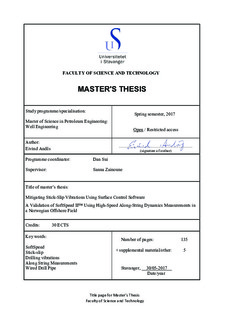| dc.contributor.author | Andås, Eivind | |
| dc.date.accessioned | 2017-10-24T12:19:47Z | |
| dc.date.available | 2017-10-24T12:19:47Z | |
| dc.date.issued | 2017-05-30 | |
| dc.identifier.uri | http://hdl.handle.net/11250/2461834 | |
| dc.description | Master's thesis in Petroleum engineering | nb_NO |
| dc.description.abstract | Stick-slip is a well known drilling related problem that causes damage and
delays, often resulting in an overall more expensive well. These problems
have traditionally been remedied by reducingWOB or increasing RPM when
possible and most often the ROP is reduced as a consequence. In some cases,
it is not possible to compensate for the vibrations as it would stop any progress,
and stick-slip must then be tolerated with the potential damages that follows.
Remedial processes for stick-slip has been an important field of study. A
recent development is the SoftSpeed II™ application by NOV which calculates
the downhole bit speed and torque values and implements remedial
string rotation to cease several modes of stick-slip vibrations. This way it is
not necessary to reduce WOB to cope with the oscillations, and ROP can be
maintained.
Bit wear will be reduced as a result of mitigating stick-slip, which in a well
may mean the difference between continued progress or an expensive bit trip.
Other side effects may include reducing lateral and axial vibrations, reducing
wear on BHA and drillstring, and improving borehole quality.
This Thesis will study the use of SoftSpeed in one field located in theNorwegian
North Sea. The reservoir contains hard conglomerates which has created
high level of vibrations in previouswells. SoftSpeed has been implemented on
the last two reservoir sections, and these two will be compared to the previous
four sections drilled in the same reservoir.
By using data from along-string dynamic sensors, the effects of SoftSpeed
on drillstring vibrations and locally induced stick-slip can be analyzed at different
intervals in the well in high resolution. Performance parameters, such
as Rate of Penetration (ROP) andMechanical Specific Energy (MSE) alongside
with a derived Stick-Slip Severity index (SSS), will ensure equal comparison
between the wells. | nb_NO |
| dc.language.iso | eng | nb_NO |
| dc.publisher | University of Stavanger, Norway | nb_NO |
| dc.relation.ispartofseries | Masteroppgave/UIS-TN-IPT/2017; | |
| dc.rights | Attribution-NonCommercial-NoDerivatives 4.0 Internasjonal | * |
| dc.rights | Attribution-NonCommercial-NoDerivatives 4.0 Internasjonal | * |
| dc.rights.uri | http://creativecommons.org/licenses/by-nc-nd/4.0/deed.no | * |
| dc.subject | petroleum engineering | nb_NO |
| dc.subject | stick-slip | nb_NO |
| dc.subject | softspeed | nb_NO |
| dc.subject | wired drill pipe | nb_NO |
| dc.subject | along string measurements | nb_NO |
| dc.subject | drilling vibrations | nb_NO |
| dc.subject | petroleumsteknologi | nb_NO |
| dc.title | Mitigating Stick-Slip Vibrations Using Surface Control Software - A Validation of SoftSpeed II™ Using High-Speed Along-String Dynamics Measurements in a Norwegian Offshore Field | nb_NO |
| dc.type | Master thesis | nb_NO |
| dc.description.version | submittedVersion | nb_NO |
| dc.subject.nsi | VDP::Teknologi: 500::Berg‑ og petroleumsfag: 510::Petroleumsteknologi: 512 | nb_NO |

